Mark your calendars for the Discovery Day Open House at CCM!
Imagine your kids discovering what it’s like to play the ukulele, violin, keyboard, flute, trumpet, drums, cello, and 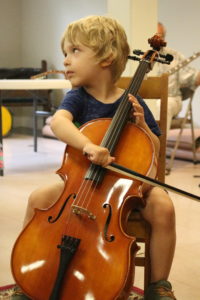 yes, even the banjo in one afternoon!
yes, even the banjo in one afternoon!
And adults can discover a host of instruments too. You’re never too old to learn music.
This year, the CCM Discovery Day Open House with its Instrument Exploration is on Saturday, September 10th, from 1:00 – 3:00 pm. It’s the perfect opportunity for adults and kids to discover which instrument is the one they want to learn. Meet and get to know our faculty, who will demonstrate how to hold and play the instruments.
Kids, newborns through age 11, can try out free demo classes during the Open House. See our schedule of demo classes and sign-up in advance.
Summer Listening Project Playlist!
To take you through the summer, our curator, Stephen Marotto, has selected pieces that are more substantial and more focused on Baroque and classical music. His narrative will guide you through the list and provide insightful background on each piece and often the instruments used in the recordings.
Are you familiar with Just Intonation and other mathematical processes to derive form and harmonies? Did you 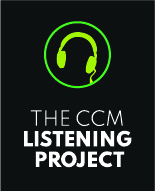 know that Ravel composed a suite inspired by fairy tales?
know that Ravel composed a suite inspired by fairy tales?
Remember to use your Listening Journal to find thought-provoking questions to think about while listening to the music. It’s a great way to start insightful conversations with your family, friends, or music instructor!
Take this shortcut to your summer playlist: Spotify
What do Fidelity, Raytheon, and State Street have in common?
They have matching gift programs.
If your employer matches tax-deductible charitable contributions, you can double the impact of your gift to CCM! Concord Conservatory recognizes and thanks to both donor and employer for this generous gesture!
Won’t you please consider giving the gift of music today?
Are you a CCM friend yet?
Join us on Instagram and Facebook to be the first to learn CCM news and more! See what music videos we like, photos we post, practice tips and articles we suggest, and new music in the music world. Be sure to bookmark the CCM Blog to never miss a new post.

It’s Saturday morning, and you’re sitting in your favorite coffee shop, maybe reading a good book, maybe meeting up with a friend….what’s that music playing in the background? Probably blues. Now it’s Friday evening, and you just got off work. You head to your favorite bar for a beer with your coworkers, and again, the music they’re playing? It’s blues. Blues lends the perfect balance of emotional lyrics and soothing melodies that just makes you want to both get up and talk to people and also sit down and take things slow.
What is blues, and where did it come from? 
Blues is a genre of music easily identified by components like its walking bassline (the steady bass part that “walks” between the chords in a chord progression and keeps the song moving forward), microtonic notes (the blues-y sounding notes which exist in-between the semitone notes played on a piano), melismas (when multiple notes are sung during a single syllable), and call-and-response lyrics. Blues groups usually have someone playing the guitar (these days usually electric), as well as drums, double-bass, brass instruments like a saxophone, and a vocalist.
Blues music got its start in the Deep South of the United States right after the American Civil War. According to Lamont Pearly Sr. of the African American Intellectual History Society, blues is a genre inspired by the call and response of African American spirituals and work songs from the times of slavery, but itself is more the expression of freed slaves and their descendants. While the emancipation proclamation ended slavery in the United States in 1863, African American people in the US faced years and years of overt violence and discrimination in the following Jim Crow era, and many blues songs from this period tell the story of those hardships and the perseverance of African American people. As blues has evolved over time, it has developed into more than simply expressing gloom, as the name ‘blues’ might imply, but rather is music made for ‘chasing the blues away.’
There are dozens of different subgenres of blues music like Delta blues, Chicago blues, or Soul blues. Each of these blues types have their own unique sound, and many evolved in a specific city or region of the country. Other types of blues music, like blues-rock, were created by artists taking inspiration from different music genres.
What’s the difference between blues and jazz? 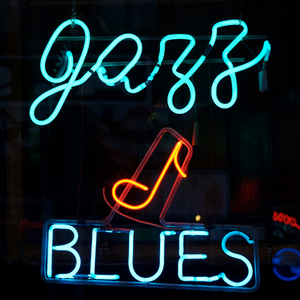
Blues and jazz have a lot in common, but they are not the same thing. Blues was a predecessor and inspiration for jazz, thus explaining the similarities. They use pretty much the same instrumentation, and both genres welcome improvisation. Blues, however, tends to be a bit more structured than jazz music. Blues songs usually stick to a small number of chords, while jazz is more likely to involve a larger variety. Some blues and jazz musicians even joke that, “A blues guitarist plays three chords in front of thousands of people, and a jazz guitarist plays thousands of chords in front of 3 people.” Furthermore, while jazz and blues welcome unconventional time signatures and improvisation, in blues, improvisation frequently takes the form of individuals taking turns playing a solo. In contrast, an entire band might improvise and play off each other simultaneously in jazz. Another key difference is that blues almost always features a vocalist, while jazz bands can frequently be only instrumental.
Is blues making a musical comeback?
People usually think of blues as a more old-fashioned type of music—reserved for smoky blues bars and clubs with an aging audience—but like most forms of art, the music industry trends are cyclical. Just like high-waisted jeans and record players, the trends that had once faded into the background can become popular again. While you might not be hearing blues music taking over pop radio stations anytime soon, a fair amount of popular songs are taking inspiration from blues music. John Mayer is one example of a popular modern musician whose music shows clear blues influence. Some classic rock songs that you may know and love might even be covers of blues songs written back in the early 1900s! For example, Led Zeppelin covered the song “I Can’t Quit You Baby” on their debut album, but the song was originally written by Wilie Dixon and recorded by Otis Rush in 1956. Next time you’re listening to your favorite songs by artists like Alicia Keys or Beyonce, be sure to listen for melismas and other blues techniques originally introduced by musical icons like BB King and Billie Holiday!
How can you learn about blues? 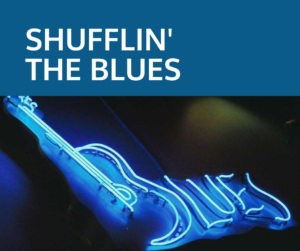
This fall, CCM is excited to introduce our newest course, Shufflin’ the Blues, taught by CCM faculty Michael Dinallo. Dinallo will be guiding students through an exploration of all sorts of different subgenres of blues music, from Chicago to Texas and more. Each ninety-minute class, Dinallo will spend the first half hour teaching about a song specific to that week’s class, and then for the last hour, everyone will learn to play the song together and, as a group, explore the many different musical interpretations of the piece. For more information, check out your other options!
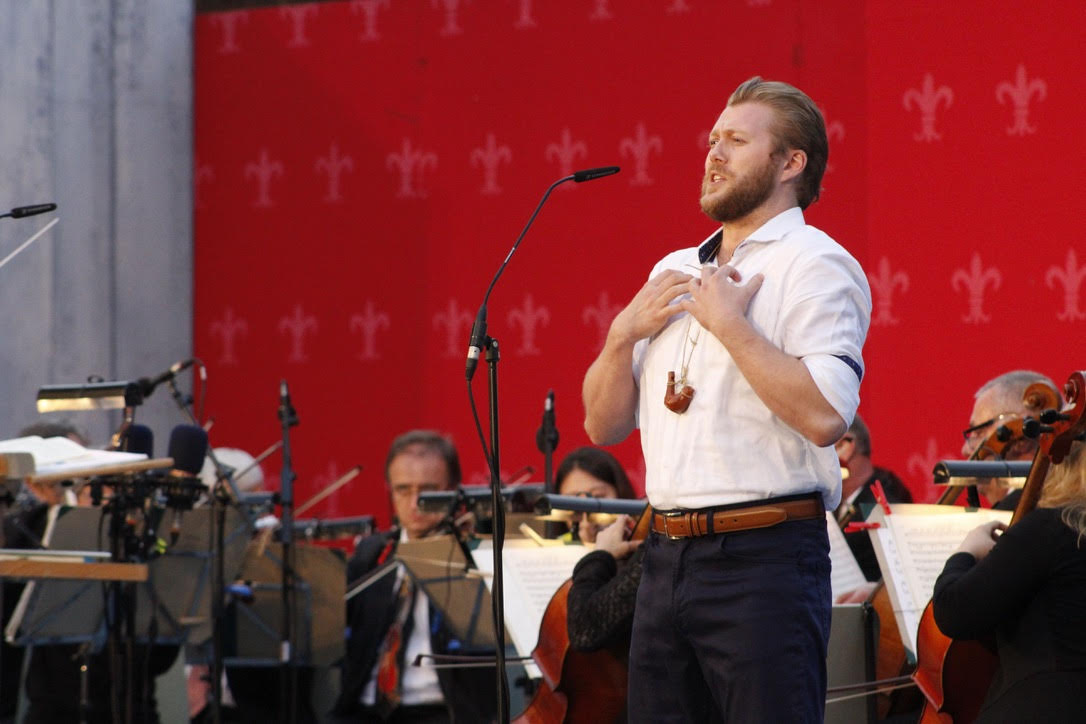
Think you can’t sing? Gray Leiper thinks otherwise. “If you can speak,” says Gray, a voice teacher and Girls Chorus Director at CCM, “you can sing. That is my fervent belief. The way I look at singing, it is just a very complex and organized way of speaking.”
The greatest challenge for a budding singer is to overcome inhibition and feelings of inadequacy. “I tell my students, ‘You don’t need to compare your voice to your friends’ voices,’ ” Gray says. “Every voice is different.”
And you certainly shouldn’t compare yourself to a professional. No one should expect to sound like Bruno Mars — Gray included. “I wish!” he says with a laugh. “I’m a huge Bruno Mars fan. I cannot sing like him, though.” 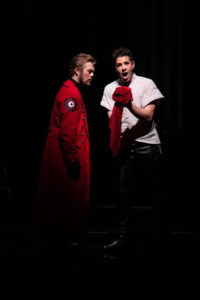
But the point is not to sing like Bruno Mars — again, it’s to sing like you. “Our job as singers is to communicate,” Gray says.
Singing, in the end, is a form of storytelling. And you don’t have to sound like Bruno Mars to communicate a powerful story. Consider another popular singer: Bob Dylan. “He may not have the sweetest voice,” Gray says, “but he’s an incredible storyteller.”
True Story
Gray’s own story is testament to the power of finding your own voice. Growing up in Houston, Texas, he was steeped in the contemporary pop singers of the time, including Avril Levigne and Adam Levine. And yet somehow, with no classical music background whatsoever, he ended up singing German opera. In German. In Germany.
How did that happen? “That was kind of a funny turn of events,” Gray says.
Gray’s older brother, Macon, sang in choir and also took theater. “Being the competitive younger brother,” Gray says, “I wanted to keep up with him.”
When Macon started taking voice lessons, Gray decided he would try to outdo him. His teacher, Michael Vaughn,  saw a spark in the spunky little brother. So he eventually challenged him to try an Italian opera. Gray nailed it. “After that, opera became a passion of mine,” he says.
saw a spark in the spunky little brother. So he eventually challenged him to try an Italian opera. Gray nailed it. “After that, opera became a passion of mine,” he says.
From there, Gray went on to receive a Bachelor of Music in Vocal Performance from Oklahoma City University, and a Masters of Music in Vocal Pedagogy and Opera Performance at The Boston Conservatory at Berklee. But he has never lost that sense of adventure and vocal exploration he felt as a kid.
That makes him an ideal voice teacher for students of all ages. He uses everything from cartoon characters to animal sounds to get his students to find vocalization styles that suit their purposes. “As humans, we can all make sounds associated with different emotions, whether it’s crying or calling out, or even something subtle like a smirk,” Grays says. “Just the way you say smirk suggests a smirk. And we can filter those subtle sounds we create through singing in order to tell a story. It’s just a matter of figuring out how to interpret a particular sound so that you can tell the story in the best way.”
All Together Now
Teaching chorus is a particular challenge. In addition to helping his students find their voices as individuals, Gray must also get them to find their voice collectively. “I try to create a team environment,” he says. “If you put yourself first, you’re neglecting the larger ensemble. Yes, there are solos, but at some point you need to step back from the solo and come back into the ensemble.”
Fortunately, that’s rarely an issue. “One of things I love about chorus, especially in the age range I teach (9-14), is that each of these kids has challenges, but subconsciously they’re helping each other out,” Gray says. “On some level they realize that the point isn’t to be a bunch of soloists who happen to be performing together — it’s to create one unified voice.”
Ending on a High Note (Even if You Can’t Hit It)
In the end Gray doesn’t care why his students want to sing. He’s just glad they do. “I think singing, whether you do it professionally or not, is just good for you,” he says. “It’s a full-body activity that gets you breathing and gets you emoting and gets you thinking about how you can make certain sounds and let go of inhibitions in a wonderful, freeing kind of way.”
That can be therapeutic for students in middle school or high school, which Gray calls “the cradle of inhibition and anxiety.”
To combat that, he says, “I like to frame all of my teaching as ‘This is a safe space to create and experiment with the sounds you can make.’ ”
Once you start to explore the sound of your own voice, and enjoy that exploration for its own sake, there’s no telling where it will lead you. “There are no bad sounds,” Gray says. “If someone tries to sing a high note and they crack, I don’t think that’s a bad sound. It’s just an exploration of their voice. They might even use that cracking at some point — maybe to evoke someone who’s crying. That’s the perfect sound for that situation.”
Repeat Chorus
If one of his students were to become the next Bruno Mars, Gray would be thrilled for them. But, again, that’s not the point. “The majority of people who take lessons are not going to become professional singers,” he says. “But singing will always be important to them because it makes them feel good. Helping someone to develop the ability to sing and to enjoy doing it for the rest of their lives — I would consider that a victory as a teacher.”
Anthea Kechley – flute.
Manuel Garcia-Baro – piano, composition, theory.
YuHsin Tai – Dalcroze Eurhythmics, Rhythmic Solfege, and Group Keyboard
Holly Jennings – Early Childhood, voice, Beginner Vocals
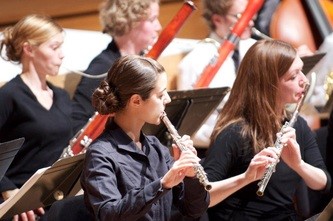
As a classically trained flutist who has performed around the United 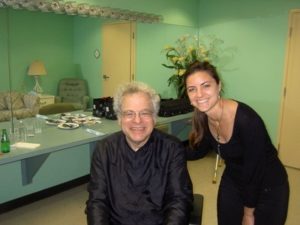 States and beyond and as an experienced educator, Anthea provides her students with the knowledge needed to develop into expressive and thoughtful musicians.
States and beyond and as an experienced educator, Anthea provides her students with the knowledge needed to develop into expressive and thoughtful musicians.
CCM is also fortunate to have Anthea in the new staff position of Programs and Community Partnerships Manager. With her extensive musical experience—which started as a toddler learning music from her professional musician parents, she’ll be programming the CCM Concert & Lecture Series and other special programming throughout the year.
Yes, that’s Anthea with violinist and composer Itzhak Perlman. Learn more about Anthea.

Manuel’s passion for music started at a young age—coinciding with beginning piano lessons at age 8. His professional music career began at age 12 when he sang on some CDs by Disney.
In addition to having a wealth of teaching experience, he’s also a composer.
Maybe you’ve heard his music before. If you’ve ever seen the Samsonite commercial title We Carry The World; then you’ve listened to his music.

Full of inspiration, love, and joy for music, YuHsin gets kids passionate about listening and moving to music. She teaches a hands-on approach to music theory in which children explore musical concepts through rhythm games, creative movement, songs, ear training, sight-singing, and improvisation.
This fall YuHsin will teach Music Makers, Musical Gateway, and Rhythmic Solfège—classes that develop a foundation of music knowledge and skills that will serve students well throughout their musical journey.

Holly enjoys a balanced career as a performing and teaching artist. She has more than a decade of experience teaching early childhood music and draws from her own experience as a parent as well.
She’s excited to bring her previous experience into a new space—in particular, she has worked in an arts-integrated literacy program where the curriculum is focused on connecting music to themes in the real world. She integrates songs that have to do with things her students see in their own lives, so they can have an enriched, multisensory experience.
At CCM, Holly teaches the Early Childhood classes Little Notes, Family Notes, and Beginner Vocals. She’s all about making music accessible—both by curating a curriculum that suits the age and abilities of her students and also by helping parents to bring the music into their homes.